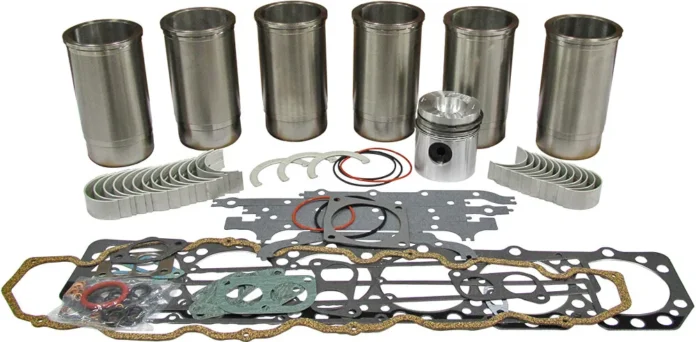In the world of heavy equipment and industrial machinery, performance is everything. When an engine starts to underperform—due to age, wear, or breakdown—the big question arises: should you buy a brand-new engine or rebuild your existing one? While both options have their advantages, deciding which is more cost-effective often comes down to your machine’s age, your budget, and long-term operational needs.
Rebuilding an engine using a quality Engine Rebuild Kit can often breathe new life into your equipment without the hefty price tag of a full engine replacement. However, that doesn’t mean it’s always the best solution. This article takes an in-depth look at both choices to help you make an informed decision.
Understanding the Basics
Before we dive into the comparison, it’s important to understand what both options involve.
What Is an Engine Rebuild Kit?
An engine rebuild kit is a packaged set of internal engine components that allows technicians to restore an old or failing engine. These kits typically include:
- Pistons and piston rings
- Cylinder liners or sleeves
- Main and rod bearings
- Gaskets and seals
- Valve train components
- Camshaft bearings
- Timing components (optional)
A rebuild refreshes the internal mechanics without replacing the entire engine block or head.
What Is a New Engine?
A new engine (often referred to as a “crate engine” or “complete replacement engine”) is exactly what it sounds like—a factory-assembled, unused engine that is installed in place of the old one. It usually includes the block, head, and fully assembled internals.
Cost Breakdown: Rebuild vs Replacement
1. Upfront Costs
- Engine Rebuild Kit: Typically ranges from $1,500 to $4,000, depending on the engine make, size, and type (diesel, gas, etc.). Add labor costs, and the total might fall between $4,000 and $8,000.
- New Engine: The cost of a brand-new engine varies widely, starting around $8,000 and going up to $30,000 or more for large industrial engines. Add labor, shipping, and setup costs, and the total could reach $35,000+.
Verdict: Rebuilding is significantly more affordable upfront.
2. Downtime & Installation
- Rebuilding often takes 1–2 weeks, depending on availability of parts and the mechanic’s schedule. However, if the damage is extensive, delays are possible.
- Installing a new engine can also take 1–2 weeks, but comes with extra logistical issues such as delivery lead time, custom fittings, and sometimes additional parts or tools.
Verdict: Roughly even, but rebuilds may offer more flexibility if you already have the parts in hand.
Performance and Longevity
Engine Rebuild
A properly rebuilt engine can perform just as well as a new one if quality parts are used and the rebuild is done by experienced hands. In fact, many industrial engines are built to be rebuilt multiple times during their lifespan.
- Life Expectancy: 70–90% of a new engine’s lifespan
- Performance: Can be restored to near-factory standards
- Warranty: Limited or part-based warranty (usually from the parts supplier)
New Engine
New engines offer the best possible performance with zero wear and often come with extended warranties.
- Life Expectancy: 100% (factory standard)
- Performance: Peak performance
- Warranty: Typically 1–3 years, sometimes more
Verdict: A new engine provides superior longevity and a warranty safety net, but rebuilds are still a strong contender for cost-conscious owners.
Environmental Impact
Rebuilding your engine is a more environmentally responsible choice compared to replacing it. Manufacturing a new engine consumes significantly more raw materials, energy, and transport resources.
- Rebuild: Reuses existing engine block and many components
- New Engine: Full production footprint with new materials
Verdict: Rebuild wins for sustainability.
Suitability for Different Scenarios
Rebuild Kit is Best If:
- You’re on a tight budget
- Your engine hasn’t suffered catastrophic failure
- You have access to skilled mechanics
- You need to keep the original engine for compliance or historical reasons
- Your equipment is otherwise in good condition
New Engine is Best If:
- Your old engine is cracked, warped, or has unrepairable damage
- You want the maximum performance and reliability
- You can afford the higher cost
- Your equipment is critical to operations and downtime is unacceptable
Additional Considerations
1. Parts Availability
Some older engine models may have limited new engine availability. In that case, a rebuild is not only more practical—it may be your only option.
2. Resale Value
Machinery with a new engine might fetch a higher resale price. However, documentation of a professional rebuild also adds resale confidence.
3. Customization and Upgrades
When rebuilding, you have the chance to upgrade certain internals (e.g., forged pistons, performance camshafts) to better suit your application.
Real-World Example
Let’s say you own a mid-size bulldozer. The engine starts consuming oil and producing white smoke. The machine itself is in good condition and serves your needs well.
- Rebuild option: Total cost around $6,000
- Replacement option: Total cost around $22,000
Assuming the rebuilt engine gives you another 7,000–10,000 hours, the cost-per-hour is much lower for a rebuild. This makes financial sense unless you’re planning a fleet overhaul or need like-new reliability for high-risk jobs.
Final Verdict: Which Option Wins?
There’s no one-size-fits-all answer—but for most heavy machinery owners, an engine rebuild kit offers the most cost-effective route when factoring in budget, performance, and environmental considerations.
Choose a rebuild if:
- You want to save money
- Your current engine block is still in usable condition
- You need to reduce downtime quickly
- You’re looking to extend the machine’s life without major investment
Choose a new engine if:
- Your current engine has suffered major structural failure
- You want new-warranty peace of mind
- You can afford the higher cost for long-term reliability
In either case, always partner with reputable suppliers like AmoParts to ensure quality, precision, and long-lasting results. Whether you’re rebuilding or replacing, smart decisions start with the right components.

